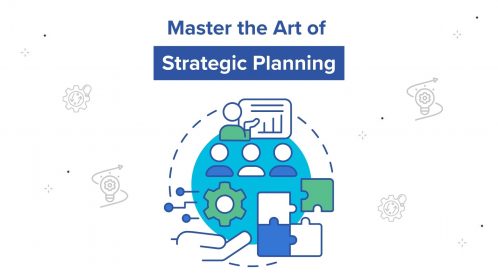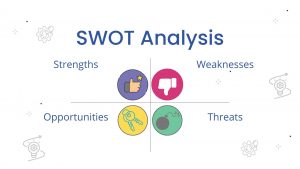
Launching a business is exhilarating, with its foundational strategic planning, organization, and execution. But what happens when the initial momentum fades? Many companies get stuck operating on autopilot, lacking a clear direction. The culprit? The gap between long-term goals and actionable steps. Your initial plan wasn’t a “strategic plan,” it was just a launchpad. Strategic planning is the roadmap, guiding you towards long-term success. Dive deeper to learn how it ignites growth and propels your business forward.
Strategy and Planning are not the Same
Many use “strategy” and “planning” interchangeably, but they’re as different as a compass and a map. Imagine sailing into the vast unknown. A detailed plan, like a map, lays out every step. It’s valuable, but it’s inflexible for unexpected detours or challenges. Strategy, on the other hand, is your compass. It sets your overall direction, anticipating potential obstacles and allowing for adjustments as the journey unfolds. Strategy sets the course; planning guides the way.
In another way, the “big picture”—your long-term goals, mission, and competitive advantage—is the emphasis of strategy. It plots the path to your intended destination with the “what” and “why.” This notion is turned into concrete steps by planning the “how” and “when.” Your path is mapped out in detail, with resources assigned, deadlines set, and backup plans integrated.
Together, strategy and planning become the essential tools for achieving long-term success.
What a Strategic Plan is
Strategic planning is a comprehensive process that sets the long-term direction for an organization. It involves a high-level assessment of the organization’s vision, mission, and competitive advantage within the broader business landscape. This future-oriented process, typically spanning 3–5 years or more, considers both internal and external factors, allowing for adaptation as circumstances evolve. To build a strong strategy, organizations engage in critical thinking, including framing the right questions, learning from past experiences, diagnosing root causes, and forecasting future trends. This analysis allows them to search for potential pathways, choose the most effective course of action, and integrate the strategy into existing operations. Finally, successful strategic planning requires a commitment to change and the ability to evolve as circumstances necessitate.
In one of Harvard’s Business Strategy Courses, Harvard Business School Professor Clayton Christensen says, “When we run into unanticipated opportunities and threats, we have to respond. Sometimes we respond successfully; sometimes we don’t. But most strategies develop through this process. More often than not, the strategy that leads to success emerges through a process that’s at work 24/7 in almost every industry.”

The Need for Strategic Planning
Maintaining a competitive edge requires strategic planning. This ongoing process involves analyzing the market, crafting strategies, putting them into action, and then tracking their effectiveness. While there is no guaranteed path to success, strategic planning is crucial for most businesses. The Strategic Management book by Rothaermel shows companies with a competitive advantage typically outperform their industry peers financially.
Having a strategy also broadens perspective. It allows decision-makers to see the whole picture of their company and its environment, leading to more informed choices that secure a competitive edge. Additionally, this planning fosters collaboration by including middle management from various departments. Involving them eases the implementation of the strategies and makes them committed to support, leading to smoother integration across the company and improved communication at all levels.
The Strategic Planning Process
The ideal strategic planning process is customizable. While each manager should tailor the approach to their specific company’s goals, size, industry, and other factors, there are core steps that provide a strong foundation:
- Assess the Company’s Standing
Use SWOT analysis to evaluate your company’s strengths, weaknesses, opportunities, and threats. As well as STEEPLE, which is shorthand for Social, Technological, Economic, Environmental, Political, Legal, and Ethical factors, and it’s used to assess external factors impacting a business environment. This will provide insights into your competitive position and potential areas for improvement.

- Define the Objectives
Set clear and aligned goals that correspond with your company’s mission. Prioritize the most crucial objectives, considering factors such as available resources, timelines, and KPIs and targets. This will help determine how much funding you need and what staffing, space, and equipment you’ll require.
- Formulate the Plan
Collaborate with your team to outline the specific steps necessary to accomplish your prioritized goals. Craft short-term action plans that contribute to your long-term vision, while ensuring your strategy remains focused on your overarching goals.
- Execute the Plan
Put your finalized plan into action by ensuring clear communication across the organization, assigning ownership for each goal, securing necessary resources, and establishing methods for tracking progress and reporting results.
- Adapt and Adjust
Regularly review and adapt your strategic plan to align with changing market conditions and emerging opportunities. Quarterly metric reviews and annual adjustments to the strategic plan will ensure that you remain on track toward achieving your goals.
Note that bringing your strategic plan to life requires careful execution and can involve cultural shifts. Growing businesses may need to address the future role of the owner, potentially delegating responsibilities for long-term success.
The Strategic Plan Benefits
Suppose you’ve reached that far and still do not see how a strategic plan is a game changer. In that case, the following benefits will showcase how businesses of all sizes can gain an edge, make better decisions, and achieve lasting growth by utilizing strategic planning and management. It’s the key to unlocking your potential and succeeding in your business.
- Sharpen Your Focus: Strategic planning helps you cut through the noise and prioritize what truly matters. By aligning everyone around clear goals, your team can work together more efficiently, avoiding distractions and wasted effort.
- Make Smarter Decisions: Strategic planning equips you with a roadmap and a framework for analyzing options. This leads to well-informed decisions that support your long-term vision, minimizing costly mistakes and missed opportunities.
- Stay Ahead of the Curve: Strategic planning helps you anticipate market shifts and proactively adapt your strategies. This gives you a competitive edge, allowing you to capitalize on opportunities and outmaneuver competitors who lack a clear direction.
- Embrace Change and Growth: Strategic plans are living documents, not rigid blueprints. They allow you to adjust and pivot as circumstances change, fostering a culture of adaptability that fuels continuous growth.
- Boost Employee Engagement: A clear strategic plan helps employees understand the company’s goals and how their role contributes, fostering motivation and a sense of ownership.
Why Strategy Fails
Crafting a strategic plan is a vital first step, but its effectiveness hinges on the quality of its construction. Flawed elements within the strategy, even with good intentions, can lead businesses astray. Let’s explore these common pitfalls that can derail a seemingly well-conceived strategy.
- Clarity and Alignment Issues
- Unclear goals: Without defined goals, it’s hard to assess strategy effectiveness.
- Poor communication: employees need to understand their role in the strategy.
- Misalignment with company culture: Strategy must align with company values and practices.
To ensure your company culture aligns with your strategic goals, explore our guide to crafting a culture code: Culture Code: Unleashing Workplace Magic – 8WORX
- Execution Challenges
- Inadequate resources: Lack of funding, staffing, or technology hampers strategy implementation.
- Poor project management: Unclear timelines and responsibilities lead to delays.
- Inability to adapt: A rigid strategy may struggle to adjust to changing environments.
- Resistance to Change: Employees may fear the unknown and resist new ways of working.
- Monitoring and Evaluation of Shortcomings and External Factors
- Lack of clear metrics: Measurable goals are essential for tracking progress.
- Inadequate course correction: Strategies need adjustments when progress falters.
- Ignoring External Factors: Neglecting market trends and risks that can derail strategies.
By understanding these pitfalls, businesses can craft and execute more successful strategies. Aligning goals, adapting to change, and staying flexible are key to navigating the ever-evolving business landscape. This proactive approach paves the way for sustained success and growth.
We’ve explored the principles of strategic planning together. Now, it’s time for you to personalize this knowledge and create a strategic roadmap specifically for your business. Implement the guidelines you’ve learned, and share your experiences with us!